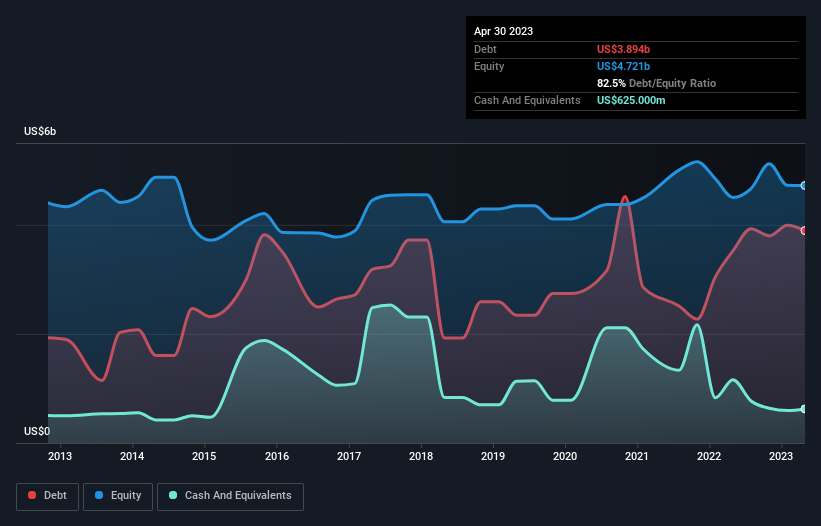- United States
- /
- Trade Distributors
- /
- NYSE:FERG
Here's Why Ferguson (NYSE:FERG) Can Manage Its Debt Responsibly

Warren Buffett famously said, 'Volatility is far from synonymous with risk.' It's only natural to consider a company's balance sheet when you examine how risky it is, since debt is often involved when a business collapses. We note that Ferguson plc (NYSE:FERG) does have debt on its balance sheet. But is this debt a concern to shareholders?
Why Does Debt Bring Risk?
Debt and other liabilities become risky for a business when it cannot easily fulfill those obligations, either with free cash flow or by raising capital at an attractive price. If things get really bad, the lenders can take control of the business. However, a more usual (but still expensive) situation is where a company must dilute shareholders at a cheap share price simply to get debt under control. Of course, the upside of debt is that it often represents cheap capital, especially when it replaces dilution in a company with the ability to reinvest at high rates of return. When we examine debt levels, we first consider both cash and debt levels, together.
Check out our latest analysis for Ferguson
What Is Ferguson's Debt?
The image below, which you can click on for greater detail, shows that at April 2023 Ferguson had debt of US$3.89b, up from US$3.52b in one year. On the flip side, it has US$625.0m in cash leading to net debt of about US$3.27b.

How Healthy Is Ferguson's Balance Sheet?
The latest balance sheet data shows that Ferguson had liabilities of US$5.13b due within a year, and liabilities of US$5.52b falling due after that. Offsetting this, it had US$625.0m in cash and US$3.38b in receivables that were due within 12 months. So its liabilities total US$6.64b more than the combination of its cash and short-term receivables.
This deficit isn't so bad because Ferguson is worth a massive US$31.3b, and thus could probably raise enough capital to shore up its balance sheet, if the need arose. However, it is still worthwhile taking a close look at its ability to pay off debt.
In order to size up a company's debt relative to its earnings, we calculate its net debt divided by its earnings before interest, tax, depreciation, and amortization (EBITDA) and its earnings before interest and tax (EBIT) divided by its interest expense (its interest cover). The advantage of this approach is that we take into account both the absolute quantum of debt (with net debt to EBITDA) and the actual interest expenses associated with that debt (with its interest cover ratio).
Ferguson's net debt is only 1.0 times its EBITDA. And its EBIT easily covers its interest expense, being 16.1 times the size. So we're pretty relaxed about its super-conservative use of debt. The good news is that Ferguson has increased its EBIT by 6.1% over twelve months, which should ease any concerns about debt repayment. The balance sheet is clearly the area to focus on when you are analysing debt. But it is future earnings, more than anything, that will determine Ferguson's ability to maintain a healthy balance sheet going forward. So if you're focused on the future you can check out this free report showing analyst profit forecasts.
Finally, a company can only pay off debt with cold hard cash, not accounting profits. So the logical step is to look at the proportion of that EBIT that is matched by actual free cash flow. During the last three years, Ferguson produced sturdy free cash flow equating to 58% of its EBIT, about what we'd expect. This cold hard cash means it can reduce its debt when it wants to.
Our View
Happily, Ferguson's impressive interest cover implies it has the upper hand on its debt. And its net debt to EBITDA is good too. Taking all this data into account, it seems to us that Ferguson takes a pretty sensible approach to debt. While that brings some risk, it can also enhance returns for shareholders. There's no doubt that we learn most about debt from the balance sheet. But ultimately, every company can contain risks that exist outside of the balance sheet. We've identified 2 warning signs with Ferguson , and understanding them should be part of your investment process.
If you're interested in investing in businesses that can grow profits without the burden of debt, then check out this free list of growing businesses that have net cash on the balance sheet.
New: AI Stock Screener & Alerts
Our new AI Stock Screener scans the market every day to uncover opportunities.
• Dividend Powerhouses (3%+ Yield)
• Undervalued Small Caps with Insider Buying
• High growth Tech and AI Companies
Or build your own from over 50 metrics.
Have feedback on this article? Concerned about the content? Get in touch with us directly. Alternatively, email editorial-team (at) simplywallst.com.
This article by Simply Wall St is general in nature. We provide commentary based on historical data and analyst forecasts only using an unbiased methodology and our articles are not intended to be financial advice. It does not constitute a recommendation to buy or sell any stock, and does not take account of your objectives, or your financial situation. We aim to bring you long-term focused analysis driven by fundamental data. Note that our analysis may not factor in the latest price-sensitive company announcements or qualitative material. Simply Wall St has no position in any stocks mentioned.
About NYSE:FERG
Ferguson Enterprises
Distributes plumbing and heating products in the United States and Canada.
Good value with adequate balance sheet and pays a dividend.
Similar Companies
Market Insights
Community Narratives



